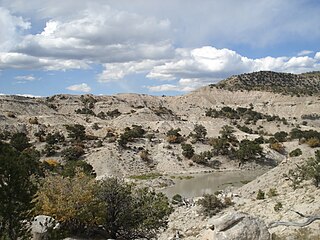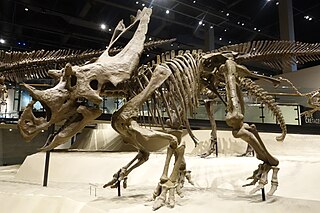
Meniscoessus is a genus of extinct multituberculates from the Upper Cretaceous Period that lived in North America.
Paracimexomys is a genus of extinct mammals in the extinct Multituberculata order. Paracimexomys lived during the Cretaceous period. The few fossils remains come from North America. Some Romanian fossils were also tentatively assigned to this genus, though that classification now seems doubtful.
Cedaromys is an extinct mammal which lived during the Upper Cretaceous, at the same time as many dinosaurs. It was a member of the also extinct order of Multituberculata. It's within the suborder of Cimolodonta, and a possible member of the Paracimexomys group.

Didelphodon is a genus of extinct metatherian mammal from the Late Cretaceous of North America.

Gryposaurus was a genus of duckbilled dinosaur that lived about 80 to 75 million years ago, in the Late Cretaceous of North America. Named species of Gryposaurus are known from the Dinosaur Park Formation in Alberta, Canada, and two formations in the United States: the Lower Two Medicine Formation in Montana and the Kaiparowits Formation of Utah. A possible additional species from the Javelina Formation in Texas may extend the temporal range of the genus to 66 million years ago.

Alphadon is an extinct genus of small, primitive mammal that was a member of the metatherians, a group of mammals that includes modern-day marsupials. Its fossils were first discovered and named by George Gaylord Simpson in 1929.

Hagryphus is a monospecific genus of caenagnathid dinosaur from southern Utah that lived during the Late Cretaceous in what is now the Kaiparowits Formation of the Grand Staircase–Escalante National Monument. The type and only species, Hagryphus giganteus, is known only from an incomplete but articulated left manus and the distal portion of the left radius. It was named in 2005 by Lindsay E. Zanno and Scott D. Sampson. Hagryphus has an estimated length of 2.4–3 metres and weight of 50 kilograms.
The Kaiparowits Formation is a sedimentary rock formation found in the Kaiparowits Plateau in Grand Staircase–Escalante National Monument, in the southern part of Utah in the western United States. It is over 2800 feet thick, and is Campanian in age. This Upper Cretaceous formation was formed from alluvial floodplains of large rivers in coastal southern Laramidia; sandstone beds are the deposit of rivers, and mudstone beds represent floodplain deposits. It is fossiliferous, with most specimens from the lower half of the formation, but exploration is only comparatively recent, with most work being done since 1982. It has been estimated that less than 10% of the Kaiparowits formation has been explored for fossils. The Natural History Museum of Utah has conducted most fieldwork.

Deltatheroida is an extinct group of basal metatherians that were distantly related to modern marsupials. The majority of known members of the group lived in the Cretaceous; one species, Gurbanodelta kara, is known from the late Paleocene (Gashatan) of China. Their fossils are restricted to Central Asia and North America. This order can be defined as all metatherians closer to Deltatheridium than to Marsupialia.

The North Horn Formation is a widespread non-marine sedimentary unit with extensive outcrops exposed in central and eastern Utah. The formation locally exceeds 3,600 feet (1,100 m) in thickness and is characterized by fluvial, lacustrine, and floodplain dominated systems, representing a terrestrial, high energy, depositional environment. The sediments date from Late Cretaceous (Maastrichtian) to early Paleocene in age and include the K-Pg extinction event boundary; however, this boundary is extremely difficult to locate and there is no strong stratigraphic evidence available that indicates a specific marker bed such as an iridium rich clay layer. Thus far, the only visible evidence is represented in the form of faunal turnover from dinosaur to mammal-dominated fossil assemblages. Taxa from the Cretaceous part of the formation include squamates, testudines, choristoderes, crocodyliforms, sharks, bony fishes, amphibians, mammals, dinosaurs, eggshell fragments, trace fossils, mollusks, plant macrofossils, such as wood fragments, and palynomorphs.

The Straight Cliffs Formation is a stratigraphic unit in the Kaiparowits Plateau of south central Utah. It is Late Cretaceous in age and contains fluvial, paralic, and marginal marine (shoreline) siliciclastic strata. It is well exposed around the margin of the Kaiparowits Plateau in the Grand Staircase – Escalante National Monument in south central Utah. The formation is named after the Straight Cliffs, a long band of cliffs creating the topographic feature Fiftymile Mountain.

Utahceratops is an extinct genus of ceratopsian dinosaur that lived approximately 76.4~75.5 million years ago during the Late Cretaceous period in what is now Utah. Utahceratops was a large-sized, robustly-built, ground-dwelling, quadrupedal herbivore, that could grow up to an estimated 4.5–5 m (15–16 ft) long.

Teratophoneus is a genus of tyrannosaurine theropod dinosaur that lived during the late Campanian age of the Late Cretaceous period, in what is now Utah. It contains a single known species, T. curriei. It is known from an incomplete skull and postcranial skeleton recovered from the Kaiparowits Formation and was specifically named T. curriei in honor of famed paleontologist Philip J. Currie.

Acristavus is a genus of saurolophine dinosaur. Fossils have been found from the Campanian Two Medicine Formation in Montana and Wahweap Formation in Utah, United States. The type species A. gagslarsoni was named in 2011. Unlike nearly all hadrosaurids except Edmontosaurus, Acristavus lacked ornamentation on its skull. The discovery of Acristavus is paleontologically significant because it supports the position that the ancestor of all hadrosaurids did not possess cranial ornamentation, and that ornamentation was an adaptation that later arose interdependently in the subfamilies Saurolophinae and Lambeosaurinae. It is closely related to Brachylophosaurus and Maiasaura, and was assigned to a new clade called Brachylophosaurini.
Talos is an extinct genus of carnivorous bird-like theropod dinosaur, an advanced troodontid which lived during the late Cretaceous period in the geographic area that is now Utah, United States.
Odaxosaurus is an extinct genus of anguid lizards that existed in western North America from the Late Cretaceous to the Paleocene. Fossils of the type species Odaxosaurus piger and the species O. priscus are widespread throughout Late Cretaceous formations in the western United States and Canada. First described in 1928 from the Lance Formation in Wyoming, O. piger has since been found in the Hell Creek Formation in Wyoming and Montana, the Frenchman and Scollard formations in Alberta, and the Aguja Formation in Texas. It was one of the few species of lizards to survive the Cretaceous–Paleogene extinction event, which is estimated to have killed off 83% of all lizard species. The second species, O. priscus, was named in 1996 from the Dinosaur Park Formation in Alberta and has since been found in the Kaiparowits Formation in southern Utah. Remains of an anguid from the Kirtland Formation in New Mexico may also belong to Odaxosaurus.

Machairoceratops, previously known as the "Wahweap centrosaurine B", is an extinct genus of centrosaurine ceratopsian dinosaur known from the Late Cretaceous Wahweap Formation of Grand Staircase–Escalante National Monument, southern Utah, United States.
Protalphadon is a genus of small mammal from the Late Cretaceous. Its fossils are found in Utah, Montana, New Jersey, South Dakota, Wyoming and Colorado. Originally the genus was assigned to Alphadon.
Scalaridelphys is an extinct genus of aquiladelphid pediomyoid mammal from the Late Cretaceous (Turonian)-aged Straight Cliffs Formation of Utah. Initially named as Scalaria in 2020, the genus name was changed to Scalaridelphys in 2021 when the authors were told by B. Creisler that the name Scalaria was already in use for a now-obsolete genus of gastropod named by Jean-Baptiste Lamarck in 1801. Two species of Scalaridelphys are known: the type species S. martini and S. aquilana.
Albertatherium is an extinct genus of alphadontid metatherians that lived during the Late Cretaceous of North America. The genus contains two species, Albertatherium primus, and Albertatherium secundus. Fossils have been found in the Eagle Formation of Montana and the Milk River Formation of Alberta.











